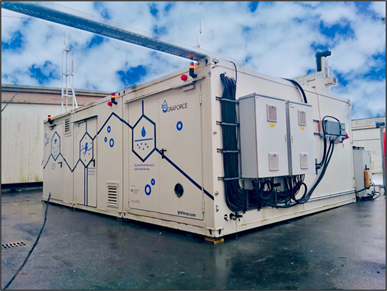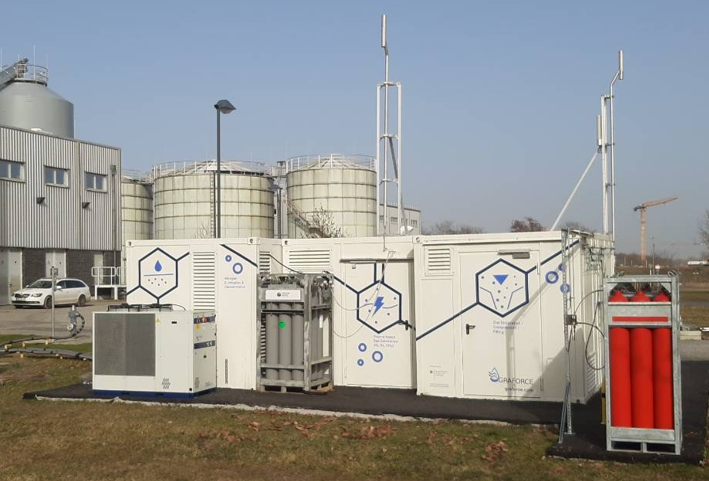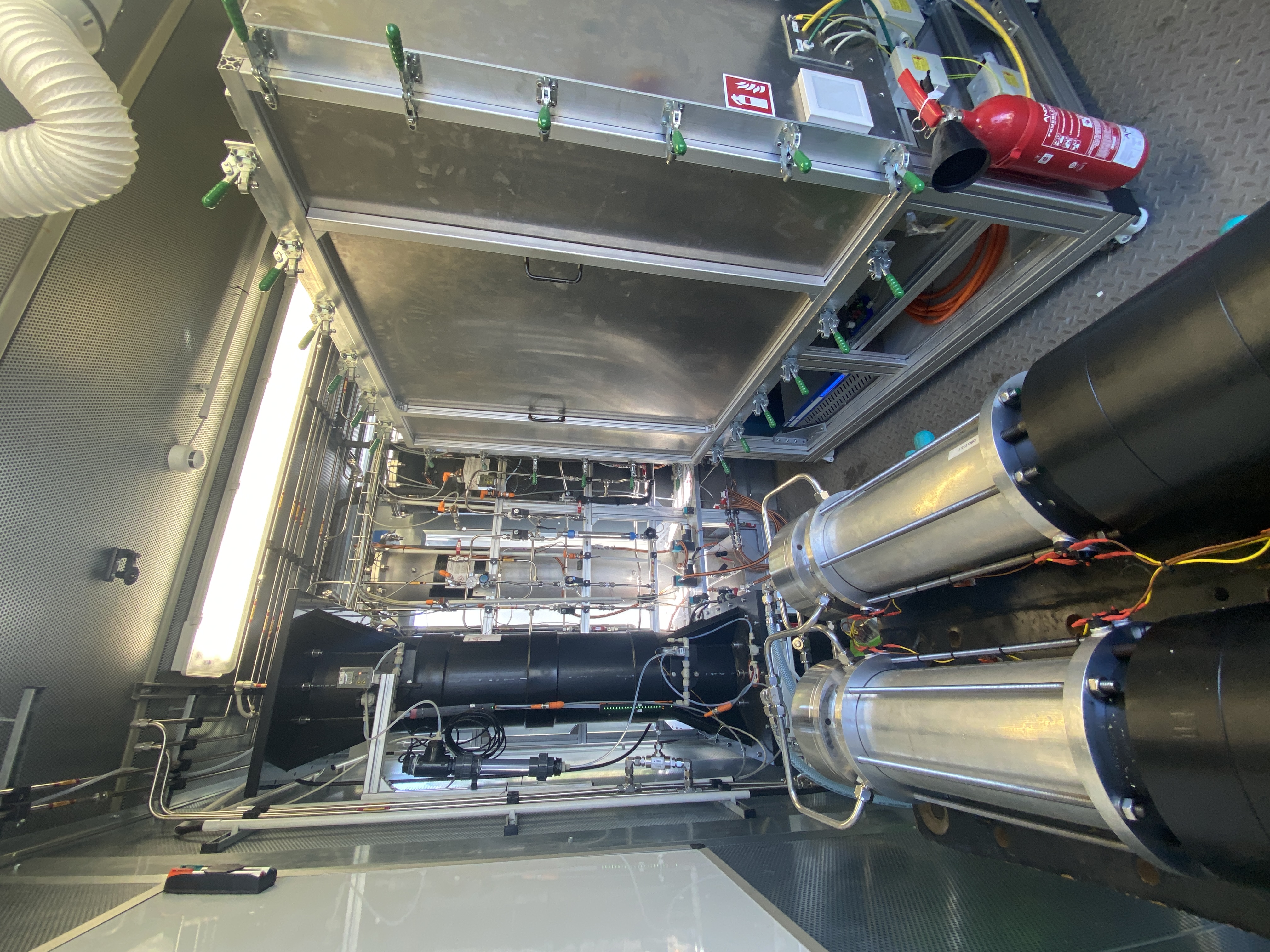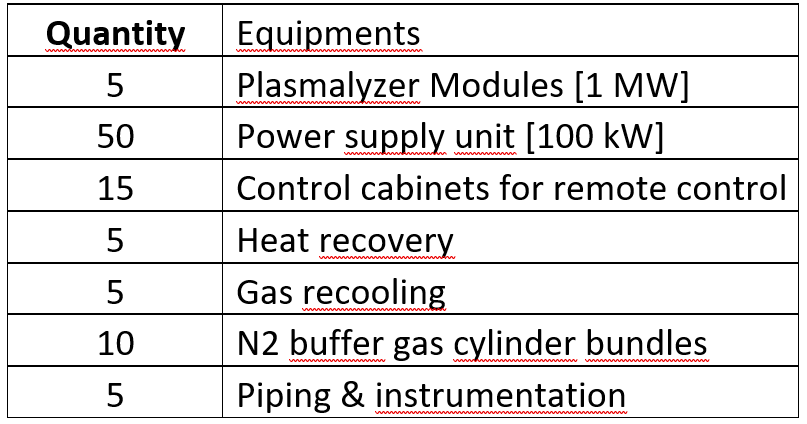Plasma Ammonia Cracker
Our ammonia cracking system has already proven its performance with various users. The unit is fully containerized, safe, and self-sufficient – ready to produce next-generation hydrogen from gaseous ammonia.
Are you interested in a site visit or testing the unit at your company location?


We are revolutionizing hydrogen production with a CO₂-free plasma process that uses ammonia as a feedstock. Our technology offers the lowest electricity consumption in the industry between 8.0 - 8.5 kWh per kilogram of hydrogen, while delivering high-purity hydrogen (99.5%) without the need for complex purification. We are proud of what we have achieved and are continuously working to expand our technological lead in order to consistently reduce costs for our customers.


The plasma modules are modular in design, allowing for parallel connections and scalability. The size of each module is determined based on the hydrogen volume required in a small scale (<250 Nm3/h) and medium scale (250-1,000 Nm3/h) format.
By using ammonia as a feedstock and renewable electricity, we enable CO₂-free splitting into hydrogen (H₂), nitrogen (N₂), and usable industrial heat.
How the process works:
- Input: 57 kg of ammonia (NH₃) + 80 kWh of renewable electricity
- Plasmalysis: Ammonia is split at the molecular level inside our Plasmalyzer
- Output:
- 10 kg of high-purity hydrogen (99.5%)
- 47 kg of nitrogen
- 30–50 kWh of industrial-grade heat

Preliminary process flow diagrams (PFD), considering battery limits (electricity, ammonia, hydrogen connection, by-product nitrogen handling).

How Our Ammonia Plasmalysis Works
Innovative Plasma Catalysis with DBD Technology
Our ammonia plasmalysis system is based on a highly efficient Dielectric Barrier Discharge (DBD) process, implemented in multiple chambers within a modular reactor. It combines plasma activation with heterogeneous catalysis to split ammonia (NH₃) into hydrogen (H₂) and nitrogen (N₂) – completely CO₂-free.
Reactor Design:
The cross-sectional diagram illustrates the structure of the plasma chemo-catalytic reactor:
- Circulated water: Maintains thermal stability, heating up the ammonia and system efficiency
- Catalyst pellets: Provide the active surface for ammonia decomposition
- Electrode: Generates the plasma field via high-voltage discharge with a unique electrode setup
- Dielectric barrier: Electrically separates electrodes and enables controlled plasma generation
Operating Principle:
Inside the reactor, the DBD plasma activates ammonia molecules by breaking the bonds between hydrogen and nitrogen atoms.
On the catalyst surface, these atoms recombine selectively to form:
- Hydrogen molecules (H₂)
- Nitrogen molecules (N₂)
This plasma-enhanced catalytic reaction significantly improves

Example Plant AMMONIA CRACKING Plasmalysis for the Production of 5 kt/a Hydrogen

Unit Operation Overview – 5,000 t/a Ammonia Cracker (Plasma-Catalytical Splitting)
1. Feed Gas Specifications
- Type: Anhydrous Ammonia (NH₃ gas)
- Purity: ≥ 98 Vol.% NH₃
- Allowable Impurities: ≤ 2 Vol.% N₂ or H₂, oil < 5 ppm (wt)
- Operating Pressure: 1 bara
2. Capacity & Modularity
- Modular Design: Scalable in 1 MW modules
- Turndown/Turnup Ratio: Flexible, modular operation
- Ramp Rate: 1.67 %/min per module (100%/hr)
3. Conversion Efficiency
- Hydrogen Production Target: ≥ 5,000 tonnes H₂ per year
- NH₃ Conversion Rate: 99% (on-stack basis, prior to separation and compression)
4. Process Conditions
- Operating Pressure: 1 bara
- Temperature: Up to 700 °C during plasma-catalytic cracking
5. Hydrogen Product Quality
- Post-Cracking (before purification):
- H₂: ~75 Vol.%
- N₂: ~25 Vol.%
- NH₃: < 0.1 Vol.%
- O₂/NOx: < 200 ppm
- Post-Purification & Compression:
- H₂: ≥ 99.9 Vol.%
- Pressure: 32 bar
- Total impurities: max. 200 ppm
6. Specific Energy Consumption
- Electricity Demand: 8.5 kWh per kg H₂
- Fuel Gas Consumption: None (NH₃ is the sole feedstock)
- Cooling Water: Not required / negligible (depending on system configuration)
Price: ca. EURO 15 Mio.
Your benefits:
- Zero CO₂ emissions: Fully emission-free process
- Energy-efficient: Just 8.5 kWh of electricity per kg of hydrogen
- Versatile: Suitable for industry, mobility, and decentralized energy systems
- Value creation: Nitrogen and heat as valuable by-products


